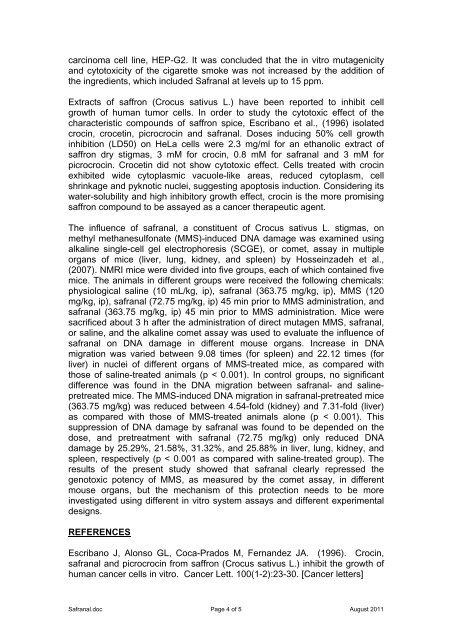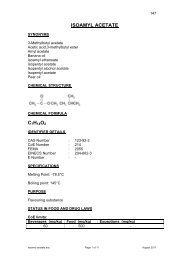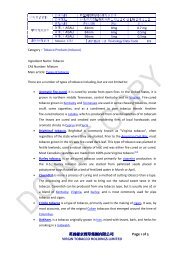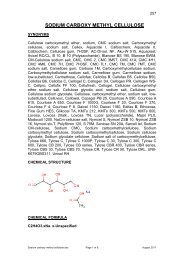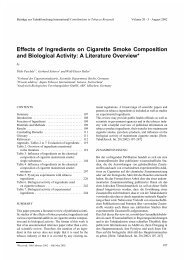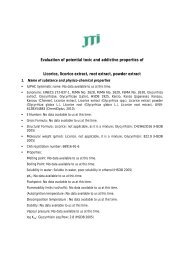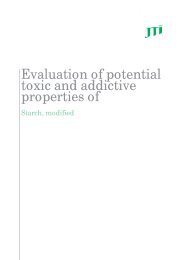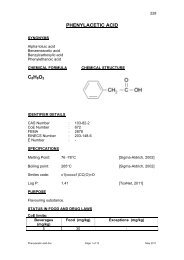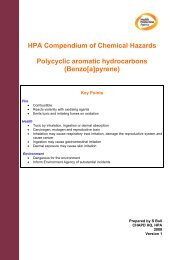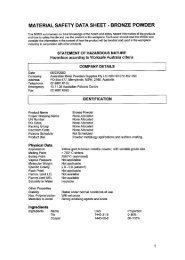You also want an ePaper? Increase the reach of your titles
YUMPU automatically turns print PDFs into web optimized ePapers that Google loves.
carcinoma cell line, HEP-G2. It was concluded that the in vitro mutagenicity<br />
and cytotoxicity of the cigarette smoke was not increased by the addition of<br />
the ingredients, which included Safranal at levels up to 15 ppm.<br />
Extracts of saffron (Crocus sativus L.) have been reported to inhibit cell<br />
growth of human tumor cells. In order to study the cytotoxic effect of the<br />
characteristic compounds of saffron spice, Escribano et al., (1996) isolated<br />
crocin, crocetin, picrocrocin and safranal. Doses inducing 50% cell growth<br />
inhibition (LD50) on HeLa cells were 2.3 mg/ml for an ethanolic extract of<br />
saffron dry stigmas, 3 mM for crocin, 0.8 mM for safranal and 3 mM for<br />
picrocrocin. Crocetin did not show cytotoxic effect. Cells treated with crocin<br />
exhibited wide cytoplasmic vacuole-like areas, reduced cytoplasm, cell<br />
shrinkage and pyknotic nuclei, suggesting apoptosis induction. Considering its<br />
water-solubility and high inhibitory growth effect, crocin is the more promising<br />
saffron compound to be assayed as a cancer therapeutic agent.<br />
The influence of safranal, a constituent of Crocus sativus L. stigmas, on<br />
methyl methanesulfonate (MMS)-induced DNA damage was examined using<br />
alkaline single-cell gel electrophoresis (SCGE), or comet, assay in multiple<br />
organs of mice (liver, lung, kidney, and spleen) by Hosseinzadeh et al.,<br />
(2007). NMRI mice were divided into five groups, each of which contained five<br />
mice. The animals in different groups were received the following chemicals:<br />
physiological saline (10 mL/kg, ip), safranal (363.75 mg/kg, ip), MMS (120<br />
mg/kg, ip), safranal (72.75 mg/kg, ip) 45 min prior to MMS administration, and<br />
safranal (363.75 mg/kg, ip) 45 min prior to MMS administration. Mice were<br />
sacrificed about 3 h after the administration of direct mutagen MMS, safranal,<br />
or saline, and the alkaline comet assay was used to evaluate the influence of<br />
safranal on DNA damage in different mouse organs. Increase in DNA<br />
migration was varied between 9.08 times (for spleen) and 22.12 times (for<br />
liver) in nuclei of different organs of MMS-treated mice, as compared with<br />
those of saline-treated animals (p < 0.001). In control groups, no significant<br />
difference was found in the DNA migration between safranal- and salinepretreated<br />
mice. The MMS-induced DNA migration in safranal-pretreated mice<br />
(363.75 mg/kg) was reduced between 4.54-fold (kidney) and 7.31-fold (liver)<br />
as compared with those of MMS-treated animals alone (p < 0.001). This<br />
suppression of DNA damage by safranal was found to be depended on the<br />
dose, and pretreatment with safranal (72.75 mg/kg) only reduced DNA<br />
damage by 25.29%, 21.58%, 31.32%, and 25.88% in liver, lung, kidney, and<br />
spleen, respectively (p < 0.001 as compared with saline-treated group). The<br />
results of the present study showed that safranal clearly repressed the<br />
genotoxic potency of MMS, as measured by the comet assay, in different<br />
mouse organs, but the mechanism of this protection needs to be more<br />
investigated using different in vitro system assays and different experimental<br />
designs.<br />
REFERENCES<br />
Escribano J, Alonso GL, Coca-Prados M, Fernandez JA. (1996). Crocin,<br />
safranal and picrocrocin from saffron (Crocus sativus L.) inhibit the growth of<br />
human cancer cells in vitro. Cancer Lett. 100(1-2):23-30. [Cancer letters]<br />
Safranal.doc Page 4 of 5 August 2011


